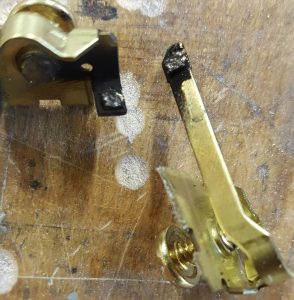A few years ago I installed improved lighting in my basement workshop. Recently I’d been noticing that the light switch sometimes made a “pop” or slight sparking noises when I switched it on or off. This seemed to be getting worse, so it was time to replace the switch. The original switch was just a household-duty 15 amp light switch, so I thought I should perhaps upgrade it to something more robust. The local Home Depot didn’t seem to stock commercial-duty switches, but I found a switch that has 20 amp capacity and also has a more definitive “click” action.
After replacing the switch I dismantled the old one for an autopsy. Here is what the contacts looked like:
 The contacts had clearly been suffering from arcing. There was a sooty deposit inside the switch in the area of the contacts as well.
The contacts had clearly been suffering from arcing. There was a sooty deposit inside the switch in the area of the contacts as well.
So what I am wondering is: why did this happen? The switch is rated for 15 amps, and it is switching 8 fluorescent fixtures each drawing a maximum of 1 amp, for a total of 8 amps. Each fixture holds two 32-watt tubes, so if the actual current draw of the fixture is probably closer to 0.6 amps each (2×32 watts for the tubes + guessing 10 watts for the ballast losses divided by 120 volts) for a total of 4.8 amps overall. Either way the switch contacts should have had plenty of capacity.
My only guess is that although the electronic ballasts in the lamps normally draw at most 1 amp, they may have a much higher peak current on startup as they charge up an internal power supply. Thus each time the lights were turned on the switch would encounter much higher current for a few milliseconds. If the switch contacts bounced much as they closed this would cause a bit or arcing, each time eroding the contacts a bit and making the contacts worse for next time.
Hopefully the new switch has a more definitive snap-closing for the contacts (reducing bounce) and more capacity to dissipate the heat generated by arcing so it will last more than the 8 years the first one did. I actually accidentally bought a double-pole switch, so even if these terminals fail again I can move the circuit over to the other as-yet-unused pole of the switch.

Leave a Reply